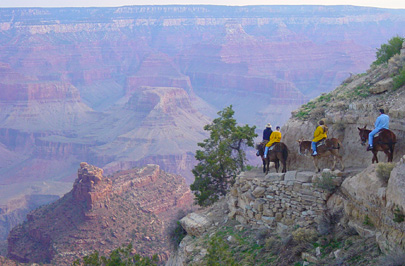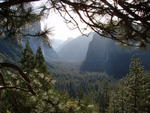
National Park Service, Mike Quinn
South Rim Mule Ride
Date: January 11, 2011
Contact: Maureen Oltrogge, 928-638-7779
Contact: Rachel Bennett, 928-638-7326
GRAND CANYON, Ariz. – The National Park Service (NPS) approved a stock use plan January 5, 2011, that allows commercial mule rides to continue at historically high levels in Grand Canyon National Park, but limits rides on some inner canyon trails that have been damaged by mule use. Private stock use remains unchanged from current use levels.
"Mule rides have always been an important part of the visitor experience at Grand Canyon," said Acting Superintendent Palma Wilson. "Our challenge with this plan was to balance that use with the protection of historic trails and to reduce the high cost of maintaining those trails. We believe this plan strikes such a balance."
The stock use plan was formally adopted by the NPS with the signing of a Finding of No Significant Impact (FONSI) by Intermountain Regional Director John Wessels. The plan adopted by the NPS was among five alternatives analyzed in an Environmental Assessment issued by Grand Canyon National Park for public review and comment in May 2010. The purpose of the EA was to examine environmental impacts associated with commercial, private and administrative stock use – guided by the following objectives:
- Provide opportunities for mule and stock use within Grand Canyon National Park to as large a cross section of visitors as practicable.
- Establish appropriate levels and types of stock use (i.e. number of stock per day, group size) on park trails that will allow for improved maintenance and reduced resource impacts and costs associated with trail maintenance.
- Through improved maintenance and operations, reduce conflicts between stock users and hikers on park trails.
- Identify optimal stock facility locations, including associated infrastructure size and locations for improving health, safety and overall visitor experience.
The stock use plan allows a potential 20 percent increase in commercial mule rides over the present yearly average on South Rim trails, and a potential 13 percent increase over the present annual average on North Rim trails. For South Rim operations, which have averaged 8,315 commercial mule rides a year for the past eight years; the new limit is up to 10,000 rides per year. On the North Rim, with an average of 7,072 commercial rides annually now, up to 8,000 commercial rides a year will be allowed.
The stock use plan will help Grand Canyon address the impact of heavy, continuous use and limited trail maintenance funds on the park's 42 miles of corridor trails – the three main routes into the inner canyon.
To aid repair and improvements, the stock plan decreases rides on the Bright Angel and South Kaibab Trails and designates an above-the-rim ride. On the Bright Angel Trail rides will be reduced from 40 rides per day (20 rides to Plateau Point and 20 to Phantom Ranch) to 10 rides to Phantom Ranch per day. These 10 rides will return on the South Kaibab Trail, once reconstruction of the trail is complete. The Plateau Point ride will be replaced by the above-the-rim ride, which offers greater flexibility and more opportunities for visitors.
The plan limits trips to Supai Tunnel on the North Kaibab Trail to 280 rides per week with a daily maximum not to exceed 48 riders a day, a number that has been exceeded less than a dozen times in recent years. The plan also eliminates the Roaring Springs ride. The Roaring Springs section of the North Kaibab Trail, a steep and narrow stretch that was expensive to maintain, was temporarily closed to mule traffic in 2009. Within one year of the change, trail degradation and associated maintenance costs declined significantly.
The plan will designate a new above-the-rim ride on the South Rim, as stated above, which will replace a temporary rim ride that was added in 2009 to accommodate visitor needs. Extensive work continues today on the 7-mile South Kaibab Trail, which is expected to accommodate mule trips returning to the rim from Phantom Ranch sometime in 2012 or 2013.
Visitors to Grand Canyon have taken guided mule trips since the early 1900s, before the park was officially established in 1919. Today, an average of 15,400 visitors a year ride mules on commercially guided trips down into the canyon and above the rim. The number of private mule and stock use is unknown because day-use permits are not required, but on average, about 60 private riders a year make overnight trips. In addition, the park uses mules for maintenance and supply trips into the canyon.
Primary elements of the preferred alternative include:
South Rim
- Commercial stock use: Up to 10,000 commercial mule rides a year (current average use is 8,315 rides)
- Bright Angel Trail: Up to 10 mule riders a day, plus up to two guides, from the rim to Phantom Ranch on the Colorado River. Day rides to Plateau Point will no longer operate
- South Kaibab Trail: Up to 10 mule riders a day, plus guides, from Phantom Ranch to the rim. In addition, up to 12 supply mules, including guides, will be allowed daily to Phantom Ranch
- Above-rim ride: Up to 40 mule riders a day, with at least one guide for every 10 riders, on a loop route from the South Kaibab trailhead to the rim near Yaki Point, continuing east another mile before returning
- South Rim stock facilities: The historic mule barn in Grand Canyon Village will continue to house a small number of commercial mules. Most of the concessioner's stock will move to the South Kaibab trailhead mule barn and corrals, which will be improved to accommodate more animals
- Private stock use: Up to six riders and six mules/horses on overnight trips below the rim. Day-use group size will be up to 12 riders and 12 stock
- Commercial stock use: Up to 8,000 commercial mule rides a year (current average use is 7,072 rides)
- North Kaibab Trail: Up to 48 riders a day, with no more than 280 in a seven-day period (average of 40 a day) to Supai Tunnel, with no more than 30 riders on the trail at one time. These numbers reflect changes from the original EA, based on public demand and meetings with the mule ride concessioner
- Ken Patrick Trail (above rim): Up to 40 one-hour mule riders a day to the Uncle Jim Trail junction, with no more than 20 mule riders on this section of trail at one time
- Uncle Jim Trail: Up to 20 half-day riders a day to Uncle Jim Point
- North Rim stock facilities: The hitching rail at Uncle Jim Point will remain in place, and a one-stall composting toilet will replace the existing facility, with weekly (or as needed) cleaning and routine maintenance
- Private stock use: Up to six riders and six mules/horses on overnight trips below the rim. Day-use group size will be up to 12 riders and 12 stock
- Commercial use at Tuweep and Whitmore Trail: Up to six stock-use groups a year at Tuweep under a commercial use authorization. These groups are limited to 12 riders and 12 stock, including guides, and are for day-use only. Stock use will be discontinued on Whitmore Trail, which is remote and not maintained
For further information, contact Rachel Bennett, Environmental Protection Specialist at Grand Canyon, at 928-638-7326 or at e-mail us.


